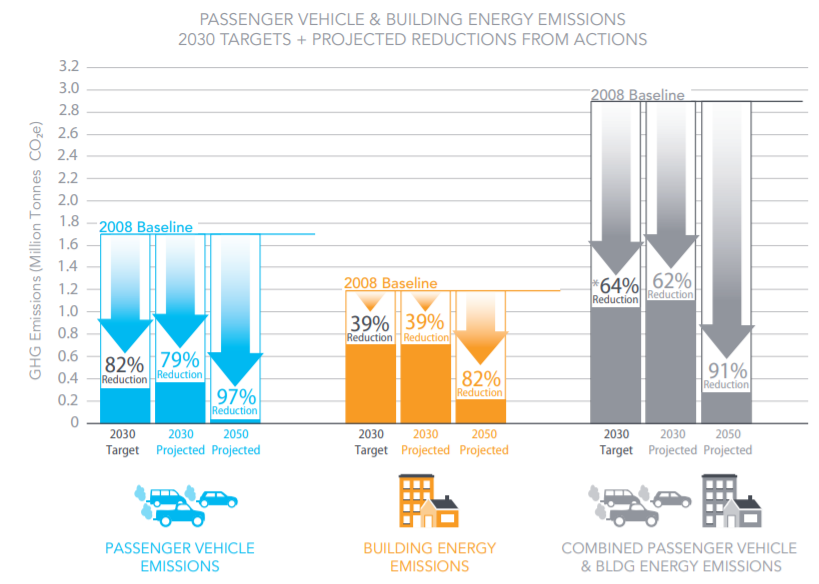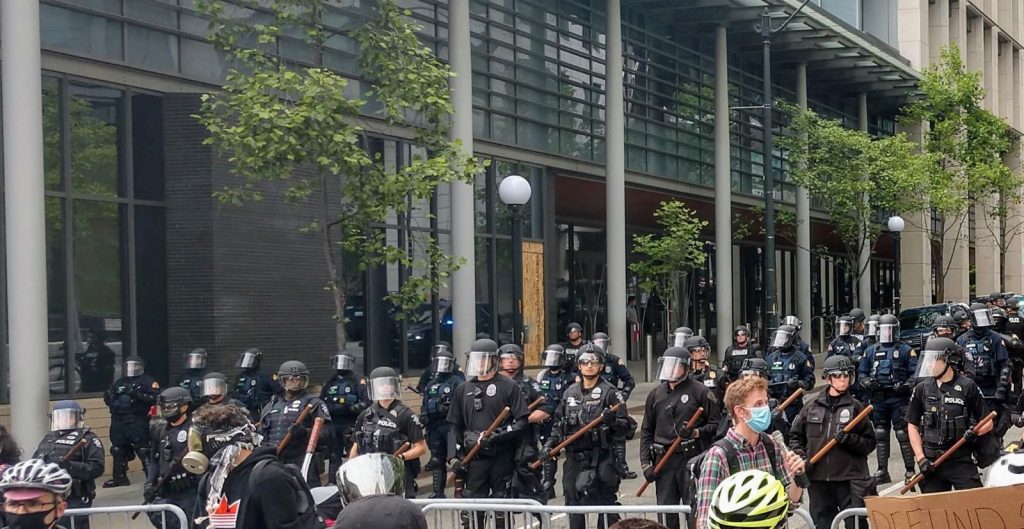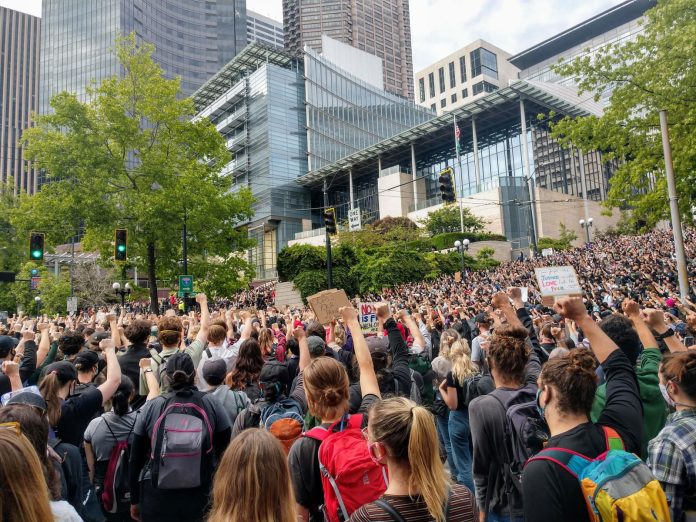
Seattle’s next mayor faces a tough job. The challenges staring down the city are many and navigating through multiple crises won’t be easy. The Covid pandemic looms over the next mayoral term, and recovering from the pandemic and shoring up the City budget will be a top concern. But the climate crisis, homelessness crisis, and racial justice reckoning won’t wait idly by while we grapple with the virus. We need to make rapid progress on those issues, too.
Will the next Mayor take the traffic safety crisis seriously? Will the next mayor put political capital and precious budget dollars into redesigning our streets to be safer for everyone? Will we elect a true climate mayor ready and willing to challenge the car-centric status quo, aggressively phase out fossil fuels, commit to lower vehicle miles traveled, and dedicate more street space to people walking, rolling, biking, and in transit?
We’ve heard lofty visions from mayors before, but rhetoric alone won’t save lives or the planet. We need to back up vision with action. We’re seeking a mayor ready to forge ahead rather than drag things out with endless studies, stakeholder mediation, and visioneering. The mayor must be a strong leader capable of inspiring, delegating, coalition-building, and making tough decisions in a complex environment.
Campaigns and journalists tend to frame every election as pivotal and high stakes. 2021 really is a uniquely consequential election year with a logjam of issues.
Seattle is not meeting its climate goals.
The city’s climate emissions continue to rise despite a goal to be carbon neutral within a few decades. Seattle’s 2013 Climate Action Plan targets a 81% reduction in transportation emissions by 2030. Eight years later, the City has failed to make any significant progress toward that goal. Our emissions have continued to climb. This isn’t just a moral problem, we’re already paying the price with smoky summers due to worsening wildfire seasons.
Seattle is off course to meet its 2030 Vision Zero goal.
Seattle set a goal of zero traffic death and serious injuries by 2030, but 24 people died navigating our streets in 2020. Even with a pandemic sapping traffic volumes, we failed to see a significant downward trend in deaths. Clearly more concerted action is needed. One big reason people avoid biking, walking, and riding transit in our city is fear of getting run over by a motorist. Our car-centered street designs don’t make them feel safe, nor do our alarming traffic statistics.
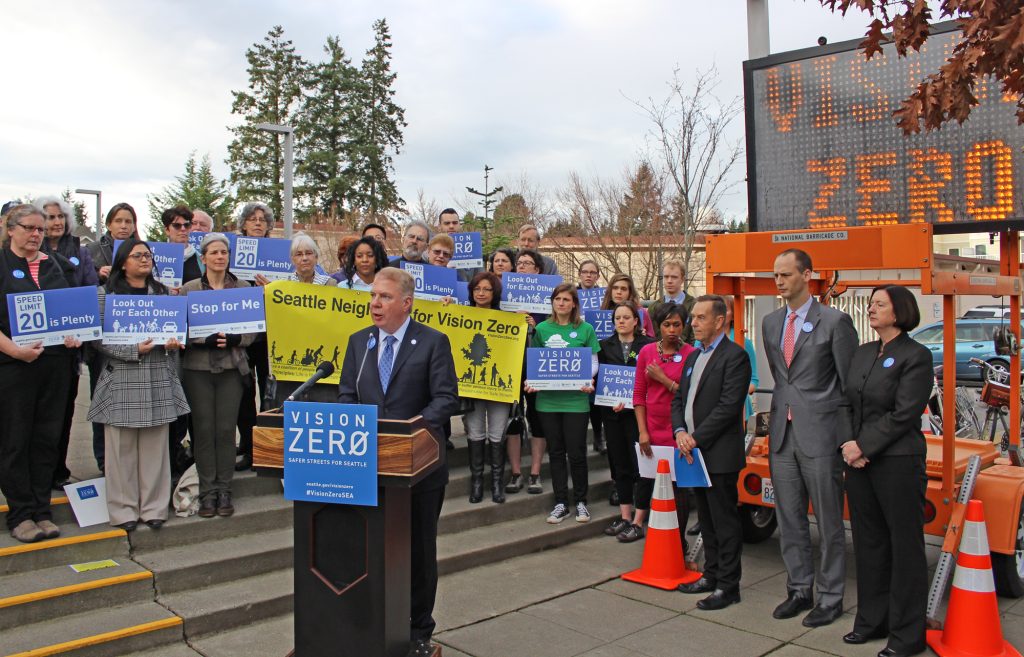
SPD is unaccountable and out of control.
The violent police response to protests last year laid bare police reform has hit a dead end at the Seattle Police Department (SPD). Seattle Police Officers Guild president Mike Solan is openly hostile to reform and City Council oversight. Police officers continue to abuse power and kill Black people with near impunity. The federal Consent Decree may be of little help. Under Mayor Durkan it was more often used to shield the department from accountability and delay reform rather than to further it.
2024 Comp Plan Update is our big chance to end apartment bans.
Cities like Minneapolis, Portland, and Sacramento have passed ambitious reforms ending detached single family zoning in their borders. Mayor Durkan opposed moves to follow in their footsteps, but the next mayor could be more visionary. Urban Villages and Centers cover less than a tenth of Seattle’s land but they handle more the 80% of its growth by virtue of their permissive zoning. This imbalance can’t go on forever. Eventually the invisible walls Seattle has put up around single-family zoned neighborhoods keeping out working class people and most people of color will have to come down.
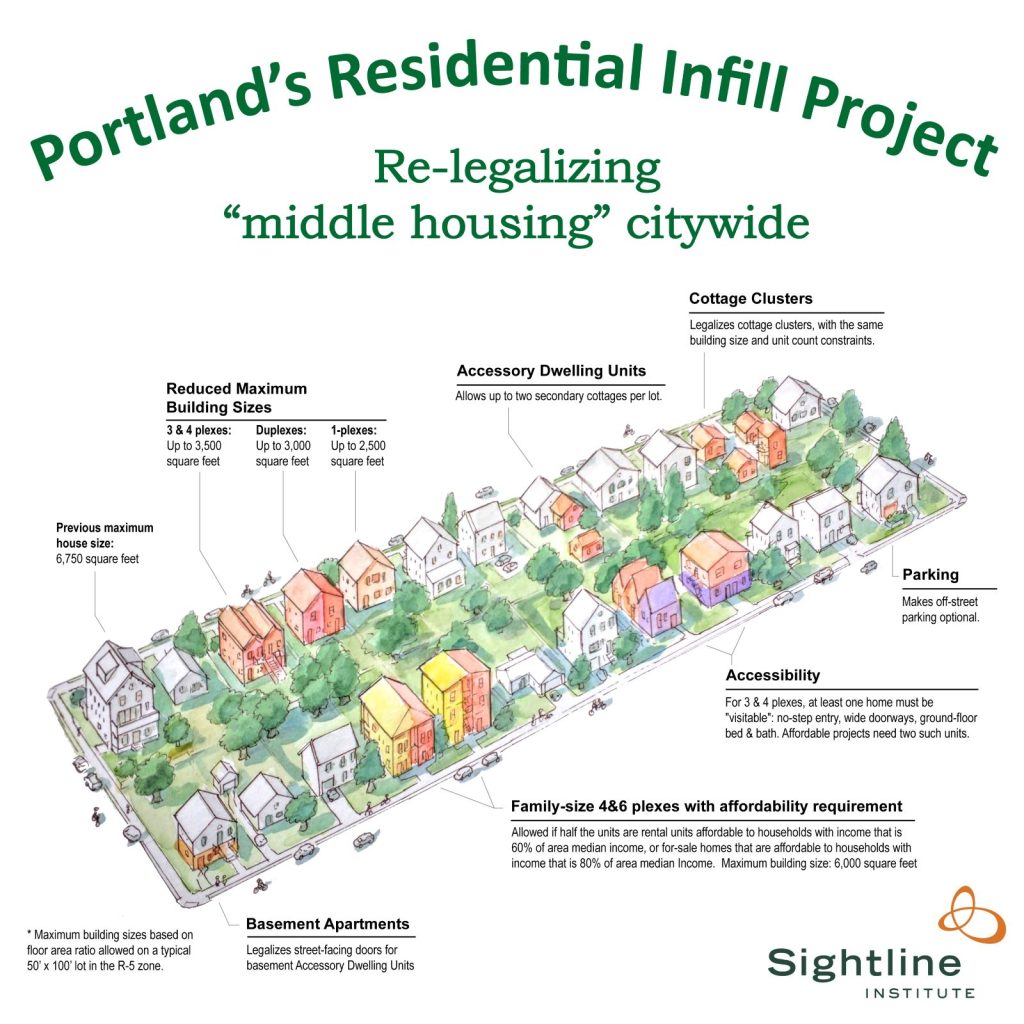
We also need to add Urban Villages, particularly where there are gaps in urban amenities, as we argued during the last major Comprehensive Plan update in 2015. Seattle will do a major update to its Comprehensive Plan in 2024, which means staff will already be readying environmental studies and analysis. This is big chance this decade to rezone Seattle and it’s on the next mayor’s shoulders.
We need a Move Seattle Levy replacement.
The Move Seattle Levy will expire in 2024 and will need to be renewed to maintain progress on expanding sidewalks, greenways, safe bike routes, and bus lanes. Plus, some Councilmembers are focusing attention on deteriorating bridges. Given the astronomical cost of bridge replacements (e.g., the Ballard Bridge), the City may need to run a separate bridge levy separately in order to raise sufficient funds and avoid bridge investments subsuming the multimodal levy.
The City must explain why Move Seattle promises fell short.
The Move Seattle Levy fell short of delivering on campaign promises including a number of RapidRide, bike, and pedestrian projects so the next levy will need to backfill the last one or another measure will need to supplement the 2015 levy. Unless the overpromising and underdelivering is rectified and explained, it makes passing future levies more fraught. Seattle next mayor’s should seek to meet Move Seattle promises while ensuring the next levy is both ambitious and realistic to deliver in full. The Durkan and Murray administrations have left quite the mess to clean up.
We need a plan to keep ST3 light rail on schedule.
Sound Transit 3 (ST3) projects are over budget and at risk of serious delay. Passing a Seattle-only “ST4” measure in 2023 or 2024 could help ST3 stay on schedule and allow Sound Transit to plan (and build ST3) to easily enable further expansions in Seattle. Without a plan to add revenue and/or trim projects costs, projects like Ballard Link and West Seattle Link could be delayed several years.
Biased law enforcement perpetuates racism.
Black, Indigenous, and people of color (BIPOC) overwhelmingly bear the brunt of our punitive law enforcement system. Misguided laws on the books like bike helmet laws and jaywalking provide pretext for Seattle police officers to make biased stops and overpolice communities of color. Data shows police don’t often enforce these laws, but when they do, homeless people and BIPOC folks remain just as disproportionately targeted. The next Mayor should direct SPD to not enforce these bias-welcoming laws and should lead the charge to take them off the books, as King County is contemplating with helmet laws. To do otherwise is to enable biased policing while discouraging people of color from walking, rolling, and biking in our streets. The research has failed to demonstrate that jaywalking laws and bike helmet laws increase safety, suggesting they are ripe for repeal.
A bridge maintenance backlog
The City Auditor estimates Seattle should spend between $24 million and $102 million per year to rectify the issue. Four SDOT bridges are in poor condition. Since some Council members have proposed skimming transit dollars to pay for it, the Mayor will need to fight to keep transit whole as the bridge maintenance issue is addressed.
The affordability crisis and social housing shortage
Combined costs of housing and transportation that represent the true cost of living (and commuting). Seattle housing prices are sky-high and the transportation system is still too car-centric and expensive. Car ownership is many times more expensive than owning an Orca card or a bike. In 2016, the average cost to own and operate a new car in Washington was $10,357 per year. To lower the cost of living in Seattle, we must expand social housing, frequent transit, and safe walking and biking networks. In Seattle, 8.6% of our housing stock is below market social housing, but 21% of tenants were severely rent burdened in 2015. The next mayor must seek to ramp up social housing production. The Seattle Housing Levy is due for renewal in 2023 and the next administration must seek to double or triple levy to scale up production.
Deciding the fate of the Center City Streetcar
After years of Durkan delay, the next mayor will either finally save the streetcar or grapple with dismantling the whole streetcar network. The Center City Streetcar would connect Seattle’s two orphan streetcar lines with total ridership projected to exceed 20,000 daily riders. However, the project faces a budget shortfall estimated at $65 million in 2019 and Mayor Durkan has shelved the project twice now.
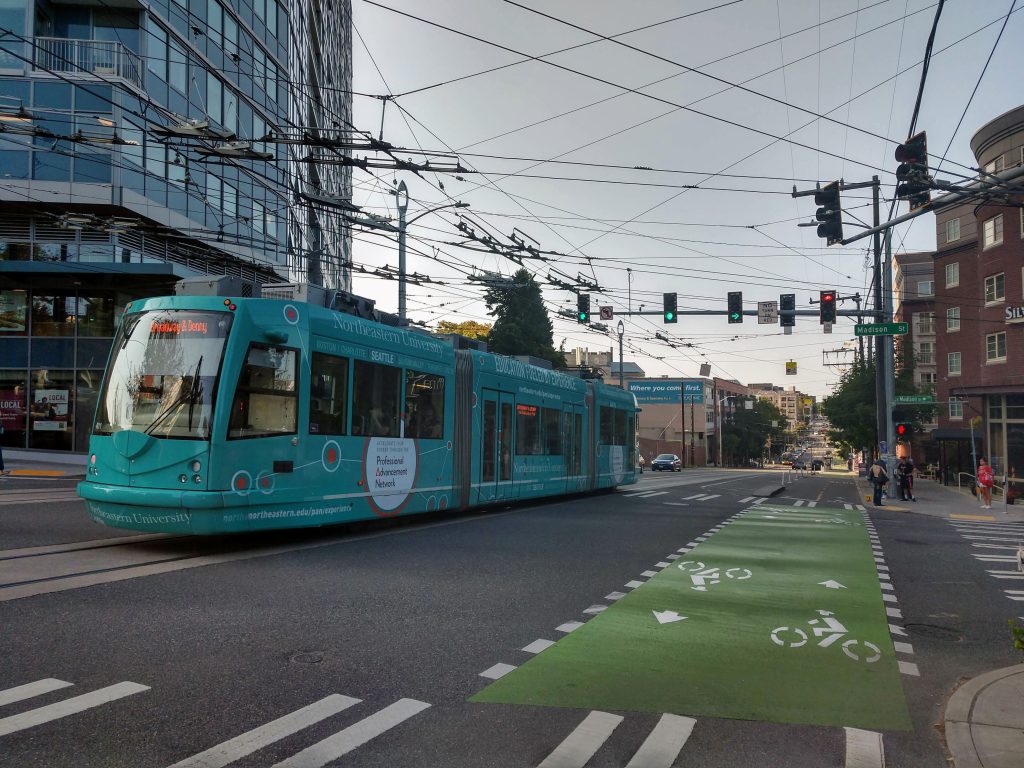
What to do about road pricing
Mayor Durkan committed to studying road pricing and made it a central tenet of her climate action plan but that was about the last we heard of it for three years. It’s a promising idea to reduce congestion, pollution, and traffic fatalities in the core of Seattle and raise funds for pedestrian, bike, and transit projects. Devising an equitable road pricing system could be a huge boon in meeting Seattle’s climate and transportation goals. At the same time, we don’t want to invest resources and hopes into a policy idea that will be difficult to enact if the mayor isn’t fully committed and ready to fight for it.
Re-envisioning Seattle
Seattle has kicked the can down the road for enough years and decades that the problems really have piled up, but there’s plenty of reason for optimism, too. There’s a growing consensus that transit investment and climate action is needed, as evidenced by Prop 1 bus measure passing with 80% of the vote last year. Seattle’s next mayor could channel that support and energy to transform the city for the better. Seattle could truly lead the way on sustainable, equitable growth with the right leadership pursuing that progressive vision.
Doug Trumm is publisher of The Urbanist. An Urbanist writer since 2015, he dreams of pedestrian streets, bus lanes, and a mass-timber building spree to end our housing crisis. He graduated from the Evans School of Public Policy and Governance at the University of Washington in 2019. He lives in Seattle's Fremont neighborhood and loves to explore the city by foot and by bike.

